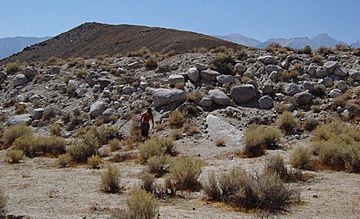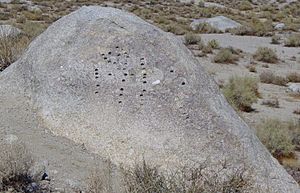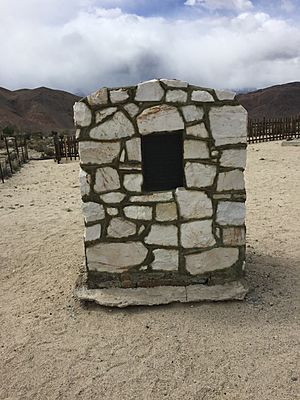1872 Owens Valley earthquake facts for kids

Lone Pine fault scarp
|
|
| UTC time | 1872-03-26 10:30 |
|---|---|
| USGS-ANSS | ComCat |
| Local date | March 26, 1872 |
| Local time | 02:30 |
| Magnitude | 7.4 Mw |
| Epicenter | 36°42′N 118°06′W / 36.7°N 118.1°W |
| Type | Oblique-slip |
| Areas affected | Eastern California United States |
| Total damage | $250,000 / limited |
| Max. intensity | X (Extreme) |
| Casualties | 27 killed 56 injured |
| Official name: Grave of 1872 Earthquake Victims | |
| Reference #: | 507 |
The 1872 Owens Valley earthquake was a very strong earthquake that shook California on March 26, 1872. It is also known as the Lone Pine earthquake. The quake happened at 2:30 AM local time. Its center, called the epicenter, was near the town of Lone Pine in the Owens Valley. This valley is on the east side of the Sierra Nevada mountains.
Scientists believe the earthquake had a magnitude between 7.4 and 7.9. This makes it one of the biggest earthquakes ever recorded in California. It was similar in size to the famous 1906 San Francisco earthquake. Sadly, 27 people lost their lives, and 56 others were hurt.
Contents
How the Earthquake Happened
This powerful earthquake was caused by sudden movements along two faults. Faults are cracks in the Earth's crust where rocks slide past each other. The main faults involved were the Lone Pine Fault and part of the Owens Valley Fault.
Imagine two huge blocks of land. During this earthquake, one block moved up by about 15 to 20 feet (4.5 to 6 meters). At the same time, it slid sideways about 35 to 40 feet (10.5 to 12 meters). This created long cracks in the ground called fault scarps. These scarps stretched for many miles, from north of Big Pine to Haiwee Reservoir.
These faults are part of a system that runs along two mountain ranges. The Sierra Nevada mountains are on the west side of the Owens Valley. The Inyo Mountains are on the east side.
The Big Shake
The earthquake struck early on a Tuesday morning. It caused almost all the buildings in Lone Pine and nearby towns to fall down. Lone Pine had about 250 to 300 people living there. Out of 59 houses, 52 were destroyed. Twenty-seven people died in Lone Pine.
Reports said that major buildings in almost every town in Inyo County were knocked down. Even 80 miles (130 km) south of Lone Pine, in Indian Wells, houses made of adobe (a type of mud brick) got cracks. The total damage to property was estimated at $250,000.
Buildings made of wood usually did better than those made of adobe, stone, or masonry (like bricks). Because of the damage, a nearby army post called Camp Independence, which had adobe buildings, had to close.
Feeling the Tremors Far Away
The earthquake was felt very strongly in many places. In Sacramento, people were woken up and ran into the streets. Even in Yosemite National Park, huge rockslides happened. The famous naturalist John Muir was living in Yosemite Valley at the time. He reportedly ran out of his cabin shouting, "A noble earthquake!" He then went to look at the fresh piles of rocks that had fallen.
The shaking was strong enough to stop clocks and wake people up in San Diego to the south. It was also felt in Red Bluff to the north, and Elko, Nevada to the east. The earthquake was felt across most of California and much of Nevada. After the main quake, thousands of smaller shakes, called aftershocks, continued for a long time. Some of these aftershocks were also very strong.
What Happened After
Scientists have studied the Lone Pine fault. They believe that earthquakes of this size happen on this specific fault only every 3,000 to 4,000 years. However, the Lone Pine fault is just one of many faults in the area.
The earthquake also created a small sunken area in the ground. Over time, this area filled with water and became a lake. This lake is now known as Diaz Lake and covers about 86 acres (350,000 square meters).
The people who died in the earthquake were buried together in a common grave. This grave is now a special place called California Historical Landmark #507.
California Historical Landmark: Grave of 1872 Earthquake Victims
This special grave is recognized as California Historical Landmark number 507. It was given this honor on July 31, 1953.
The sign at the landmark says: NO. 507 GRAVE OF 1872 EARTHQUAKE VICTIMS- On March 26, 1872, a major earthquake shook Owens Valley, nearly destroying the town of Lone Pine. About fourteen of its victims (the exact number is not known) were interred in a common grave, enclosed by this fence.




